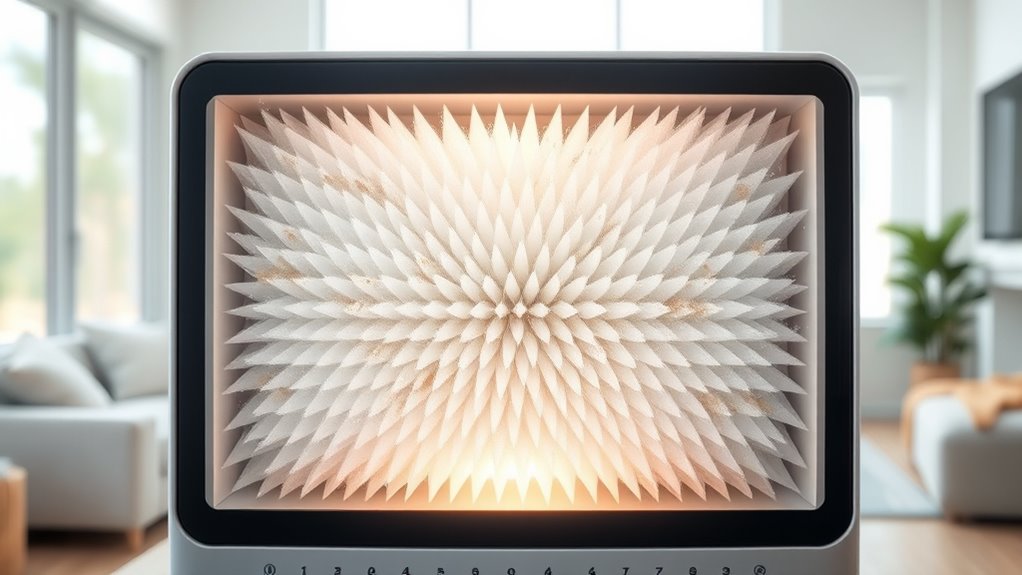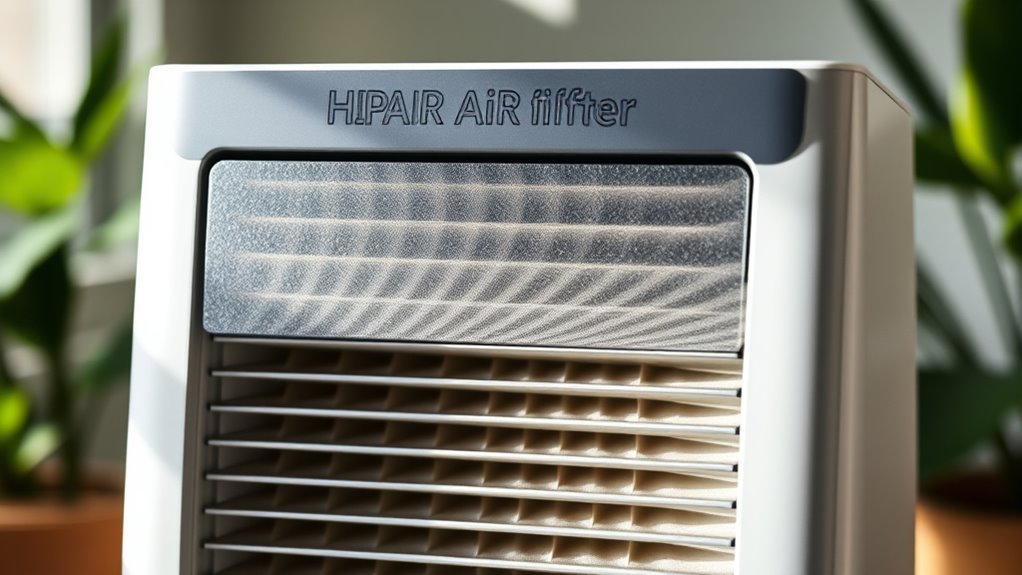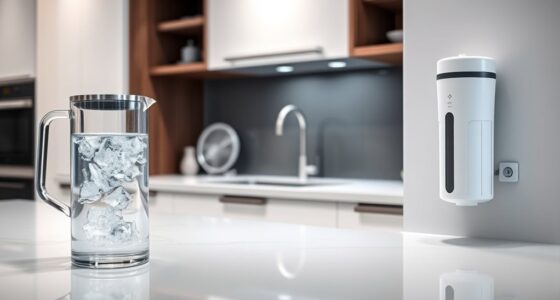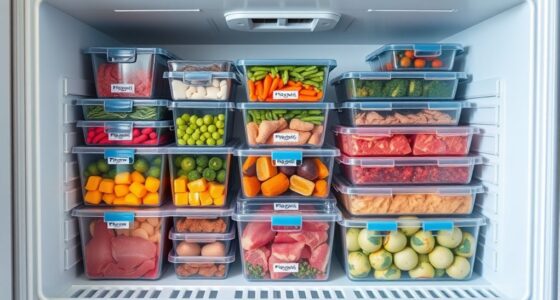HEPA filters trap tiny airborne particles by passing air through a dense fiber matrix, capturing over 99.97% of pollutants as small as 0.3 microns like dust, pollen, pet dander, mold spores, bacteria, and viruses. They work best when properly installed and maintained with regular filter changes. Different types offer varying efficiencies, and combining HEPA with activated carbon can improve removal of gases and odors. Keep learning to find the best filtration for your air quality needs.
Key Takeaways
- HEPA filters mechanically trap at least 99.97% of airborne particles as small as 0.3 microns, improving indoor air quality.
- True HEPA filters are certified to meet strict efficiency standards, ensuring effective removal of dust, pollen, pet dander, and microbes.
- Proper installation, regular filter replacement, and sealing are essential for optimal performance and cleaner indoor air.
- HEPA filters are limited in removing gases and odors; combining with activated carbon filters enhances overall air purification.
- Choosing the right HEPA filter (like H13 or H14) and considering additional technologies helps breathe easier in your environment.
How HEPA Filters Function to Remove Indoor Pollutants

HEPA filters work by mechanically trapping airborne particles as air passes through their dense fiber matrix. These filters are designed for high filtration efficiency, capturing more than 99.97% of particulate matter as small as 0.3 microns. When you use air purifiers equipped with HEPA filters, they effectively trap a wide range of indoor pollutants, including dust, pollen, pet dander, mold spores, and some bacteria and viruses. The dense fiber matrix creates tortuous pathways that increase the likelihood of particle contact and retention, removing both organic and inorganic particles from the air you breathe. This high-performance removal process guarantees cleaner indoor air by targeting particles based on their size, helping reduce health risks associated with airborne pollutants. Understanding air filtration can further enhance your knowledge of how these filters improve indoor air quality. Additionally, awareness of pinball machine weights can be useful if you plan to set up a gaming space in your home, ensuring safe and proper installation. Proper filter maintenance also plays a crucial role in maintaining the effectiveness of HEPA filtration over time.
Different Types and Classifications of HEPA Filters

Did you know that not all filters labeled as “HEPA” offer the same level of filtration? The HEPA classification and filter efficiency vary across different HEPA categories. Here’s what you should know:
- True HEPA filters meet HEPA standards, capturing ≥99.97% of 0.3-micron particles, according to certification standards like EN 1822. HEPA standards are essential for ensuring filter performance and reliability.
- HEPA classes, such as H13 and H14, differ in particle size removal, with H14 filters capturing ≥99.995%. Understanding these HEPA classes helps you select the most effective air purifier for your specific needs.
- Some filters labeled “HEPA-like” or “HEPA-type” don’t meet strict HEPA standards, offering lower filter efficiency. It’s important to verify the filter efficiency ratings before making a purchase.
- ULPA performance exceeds HEPA, capturing ≥99.999% of even smaller particles, but is used mainly in specialized industries. Proper knowledge of filter efficiency ratings ensures you get the level of air cleanliness you desire.
- Selecting the right HEPA filter involves considering the filter efficiency to match your air quality requirements, helping you breathe easier in your home or workspace.
Evaluating the Effectiveness of HEPA Filtration

Understanding how effective HEPA filtration is requires examining the mechanisms that enable these filters to trap airborne particles. HEPA filtration captures at least 99.97% of airborne particles as small as 0.3 microns, ensuring high filtration efficiency. These filters use impaction, interception, and diffusion to trap particles, which improves air quality by removing allergens, dust, pet dander, and some bacteria and viruses. The effectiveness of air purifiers depends on proper installation, sealed units, and regular filter replacement. Particle size plays a vital role, as HEPA filters excel at capturing tiny airborne pollutants. While they remove many airborne particles, they don’t eliminate gases or odors. Overall, evaluating HEPA filtration involves understanding how well these mechanisms perform against specific airborne pollutants and maintaining ideal filter conditions. Additionally, the filter’s design influences its capacity to trap particles and ensure optimal performance over time. Regular maintenance and understanding the filtration process can further enhance the overall air quality. Proper airflow and air circulation are also crucial factors that affect the efficiency of HEPA filters, ensuring that clean air is evenly distributed throughout the space for maximum benefit. Incorporating proper placement of the air purifier can also significantly improve filtration effectiveness by optimizing airflow patterns.
Proper Maintenance and Selection Tips for HEPA Filters

To guarantee your air purifier operates at peak efficiency, proper maintenance and careful selection of HEPA filters are essential. First, replace your filters every 6 to 12 months based on usage and indoor pollution levels to maintain filtration efficiency. Second, ensure your filters are certified under standards like EN 1822, confirming 99.97% particulate capture at 0.3 microns. Third, regularly check for signs of clogging or reduced airflow, which indicate it’s time for a filter replacement and help sustain indoor air quality. Fourth, buy from reputable brands such as Honeywell, Blueair, or Coway to avoid counterfeit products. Proper sealing and a high CADR also guarantee optimal airflow, maximizing filtration performance and meeting air quality standards. Additionally, choosing filters with proper filtration standards can significantly improve overall air purification.
Limitations and Additional Technologies for Optimal Air Quality

While HEPA filtration is excellent at capturing airborne particles, it has limitations removing gaseous pollutants like VOCs, odors, and chemical fumes. HEPA filters struggle with ultrafine particles smaller than 0.3 microns and don’t neutralize chemical fumes on their own. To achieve ideal air purification, you should incorporate additional technologies such as activated carbon filters, which excel at odors removal and gases. Combining filtration methods, like HEPA with activated carbon or UV germicidal irradiation, enhances overall air quality improvement. These combined filtration methods target a broader range of indoor pollutants, ensuring a healthier environment. Relying solely on HEPA filters isn’t enough for thorough air purification; integrating these additional technologies addresses gaseous pollutants and enhances your indoor air quality. Additionally, understanding the importance of filter efficiency can inspire innovative solutions in designing more effective air purification systems. For example, advancements in filter media can lead to better performance and longer-lasting filters in future air purifiers.
Frequently Asked Questions
What Are the Two Disadvantages of HEPA Filters?
The two main disadvantages of HEPA filters are that they don’t effectively remove gaseous pollutants like VOCs, odors, or fumes, so you might still smell or be exposed to harmful chemicals. Additionally, they require regular maintenance and replacement, usually every 6 to 12 months, which can add up financially and be a hassle to keep up with. If you want cleaner air, consider these limitations before choosing a HEPA filter.
Do Air Purifiers Make It Easier to Breathe?
Did you know that air purifiers with HEPA filters can remove 99.97% of airborne particles as small as 0.3 microns? Yes, they make breathing easier by reducing dust, pollen, and pet dander. When you use a properly maintained purifier, it improves indoor air quality and lessens respiratory irritants. While they don’t eliminate gases or odors, combining HEPA filters with good ventilation helps you breathe more comfortably every day.
Do HEPA Filters Work in Both Directions?
You might wonder if HEPA filters work in both directions. The truth is, they don’t. HEPA filters are designed to trap particles as air flows through in one direction only. If air tries to pass back the other way or leaks around the edges, unfiltered air can bypass the filter, reducing effectiveness. To keep them working properly, make sure they’re installed correctly with airtight seals.
How Much Does a HEPA Filter Reduce Airflow?
You might notice a slight reduction in airflow when using a HEPA filter, typically between 10-20%. This happens because the dense fibers slow down air as it passes through. The actual decrease depends on the filter’s MERV rating, thickness, and your purifier’s fan power. Keeping your filter clean and sealed helps minimize this effect, ensuring you get effective air cleaning without sacrificing too much airflow.
Conclusion
By choosing the right HEPA filter and maintaining it properly, you can substantially improve your indoor air quality. Imagine someone with allergies noticing fewer symptoms after switching to a HEPA-equipped purifier—it’s a simple change with real benefits. Remember, understanding how filters work and their limitations helps you make smarter decisions for your health. With the right approach, you can breathe easier every day and create a healthier living environment for yourself.









